|
Dried fruit is one of the
most concentrated of all fruit products and one of the simplest to
prepare. It requires no very expensive or special equipment when carried
out on a small scale.
Fruit is dried in two
ways: (a) by sun evaporation, and (b) by artificial heat. The former is
used in dry hot climates such as prevail in California and Arizona,
while the latter must often be used in climates where summer rains
occur. Both methods are discussed in the following pages.
60. Importance of the
Industry. Fruit is dried on a very extensive scale in California,
and in this state fruit drying is one of the largest horticultural
industries. It serves in this state both as a primary industry and as an
insurance against low prices for fruit grown primarily for canning or
fresh shipment. As in other states, a certain amount of cull fruit is
dried, but as a rule, the fruit used is the average orchard run. The
raisin industry in California amounts to 125,000 tons of raisins
annually, and is the largest of the state's dried fruit outputs. Prunes,
figs, peaches, pears, and apricots are also dried in large quantities.
The climate of this state is dry and hot without summer rains. This
permits drying in the sun and accounts for the size of the industry.
In other fruit growing
regions of the United States artificial heat is used almost exclusively
in drying. Drying fruit is one of the cheapest and most convenient ways
of saving surplus fruit crops. If well done the quality of the product
compares favorably with that of canned fruit.
61. Gathering the
Fruit. Drying does not improve or disguise the quality of the fruit.
To obtain dried fruit of good marketability, a good grade of fresh fruit
must be used.
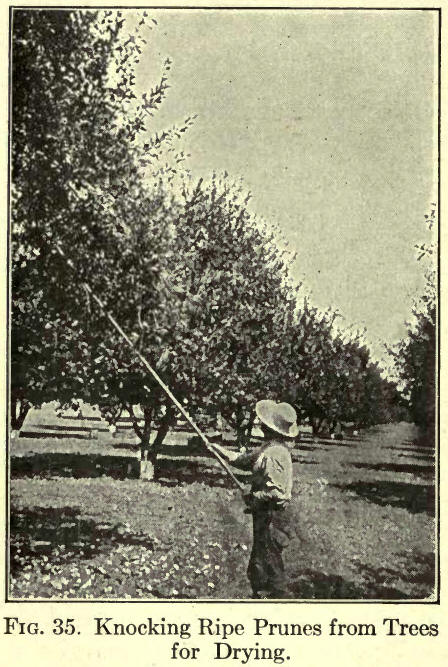
The stage of ripeness at
which the fruit is picked varies with the variety. Apricots are picked
firm ripe—if too ripe they will melt down to unattractive "slabs"; figs
and prunes are allowed to ripell until they drop from the trees of their
own accord; peaches are gathered when fully ripe, but while still firm
enough to permit handling; pears are picked when full size, but not yet
ripe, and are allowed to ripen in piles of straw before drying; grapes
are picked when fully ripe; apples for drying are usually the packing
house culls. The riper the fruit is, the more sugar it will contain and
therefore the larger the yield of dry fruit will be, unless the fruit is
overripe and so soft that excessive loss occurs.
62. Transfer to the
Dry Yard. The fruit should be taken quickly to the dry yard or
evaporator after picking and so handled that bruising does not take
place. Fruit for drying should be handled as carefully as fruit for
fresh shipment, if the best results are expected.
63. Cutting and
Peeling. Apples are peeled, cored, and cut into disks before drying.
Other fruits are usually dried without peeling.
Peaches and apricots are
cut in half and pitted by hand. Pears are cut in half lengthwise before
placing on drying trays. They are not peeled or cored. Peaches are
sometimes peeled before drying by use of a hot concentrated lye
solution. The peaches are cut and pitted; then immersed in a boiling 10%
soda lye solution for a long enough time to soften the skin thoroughly.
They are then passed through strong jets of water that wash off the
softened skins and remove the lye adhering to the pit cavities. This
method of peeling is not easily used on a small scale and is only
recommended for large dry yards.
64. Dipping Fruits
before Drying. Prunes are dipped in a hot dilute lye solution a few
seconds to crack the skins before they are dried. The dipping solution
contains about 32% of lye or one pound per thirty gallons of water, for
the French prune, the one most commonly grown. The solution is more
dilute for the Sugar Prune and Imperial Prune, two less important
varieties. The prunes are held in a wire basket in which they are
irnniersed in the hot lye solution for five to thirty seconds, or they
are carried through the liquid in a perforated rotating drum. They are
often dipped in water or are passed through water sprays to remove
excess lye and adhering dirt. The dipping checks the skins sufficiently
to greatly increase the rate of drying.
Sultanina and Sultana
seedless grapes are often dipped in hot dilute (%%) lye solution or in
sodium bicarbonate solution to crack the skin slightly or to remove the
bloom to facilitate drying. The dipping in dilute lye is also carried
out in connection with the sulphuring of Sultanina grapes (Thompson
Seedless)It increases the rate of absorption of the sulphur fumes.
Grapes after dipping in hot lye are rinsed in cold water while those
dipped in cold sodium bicarbonate solution are not rinsed in water but
are placed directly upon trays to dry.
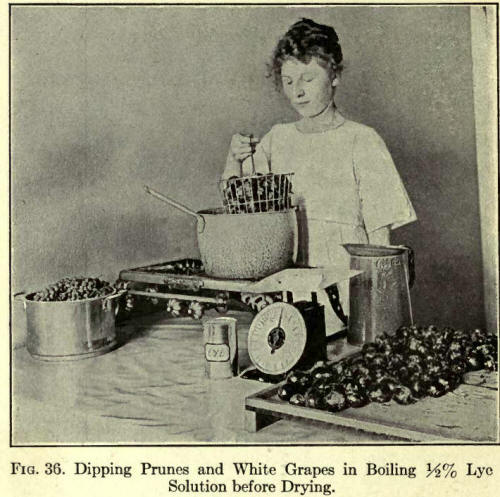
65. Sulphuring Fruits
before Drying. Fruits darken badly, unless treated with fumes of
burning sulphur before drying. The darkening is due to oxidation of the
coloring matter. Sulphur fumes prevent oxidation and darkening. In some
cases, for example in Muscat raisins and prunes, the dark color is
considered desirable; in others the dark color is objectionable.
Apricots, pears, apples,
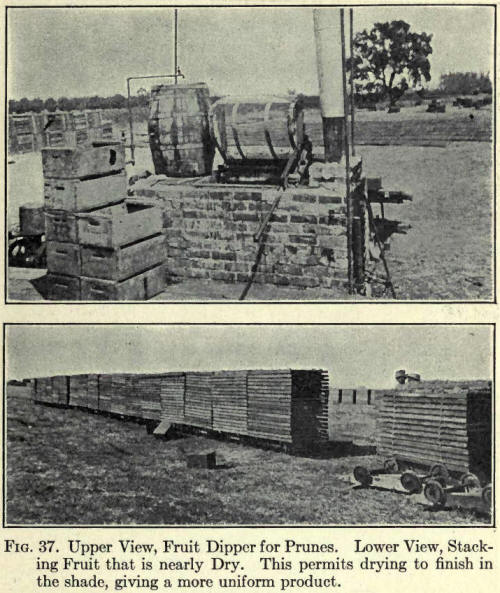
and peaches are usually
"sulphured" before drying. Sulphuring should not be excessive, because
the flavor of the fruit is thereby injured and sulphuring should never
be employed to cover up defects.
In addition to preventing
the darkening of the color, the sulphur fumes act as mild a preservative
and tend to prevent the molding and fermentation of the fruit during sun
drying.
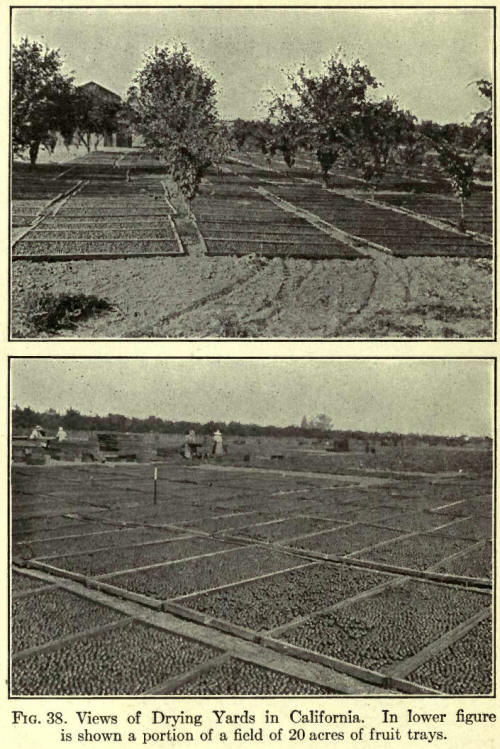
A great deal of
controversy has arisen in the past and a great diversity of opinion
exists at present as to the effect of sulphurous acid in food products
(sulphurous acid and sulphur dioxide are other names for the fumes of
burning sulphur). It is generally admitted that when large amounts of
sulphurous acid are eaten in food, injury to health results; but it is
extremely doubtful whether the relatively small amount eaten in cooked
dried sulphured fruits is harmful. Cooking drives off a great deal of
the sulphurous acid and little remains in the cooked fruit, unless the
fruit has been badly over sulphured.
The sulphuring of the
fruit is accomplished by spreading it on drying trays and exposing the
fruit and trays to the fumes of burning sulphur for the desired length
of tine. The room or box in which the sulphuring is carried out is
commonly called a "sulphur box" or "sulphur house." It may be a small
house large enough to hold a small hand truck or carload of trays, or
may be so constructed that the trays may rest on cleats on the sides of
the sulphur box. A very convenient form is the so-called "balloon
sulphur hood." This is a light rectangular wooden or building paper
covered box that can be set down over a stack of about one dozen trays.
Sulphur is burned in a
shallow pit inside the sulphur box in the ground beneath the trays, or
in a container outside the box and the fumes are conducted into the box
by means of a flue. To ignite the sulphur, a small amount of excelsior
or a few shavings may be used. The sulphur should be kept burning
constantly for the length of time it is desired to expose the fruit to
the fumes.
Apples are sometimes
sulphured by passing them on a belt conveyor through a long box filled
with sulphur fumes. Sliced apples are sulphured for twenty to thirty
minutes; apricots, peaches, and seedless grapes, three to five hours,
and. pears, six to forty-eight hours. After sulphuring, the fruit is
ready for the dry yard or evaporator.
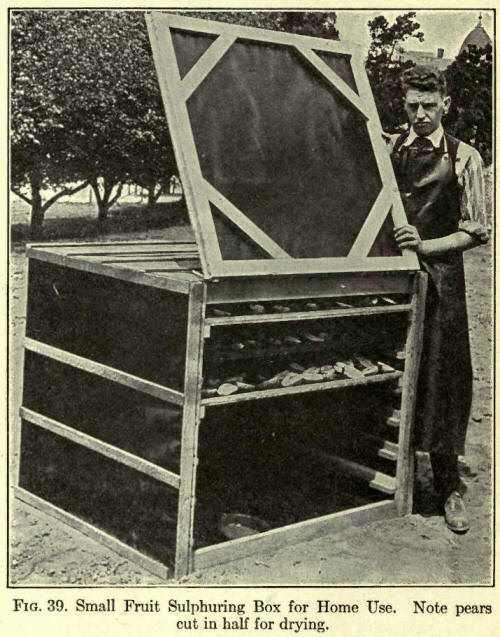
66. Trays for Sun
Drying. Wooden trays 2 x 3 feet, or 3 x 6 feet, or 3 x 8 feet are
used in sun drying fruits commercially. These are made of sugar pine or
other tasteless white wood. Redwood colors the fruit. Shakes 3" x 6" are
nailed to side strips and cleats are nailed to the ends. In long trays,
one or two narrow strips of wood are nailed lengthwise near the center
of the tray to act as a support.
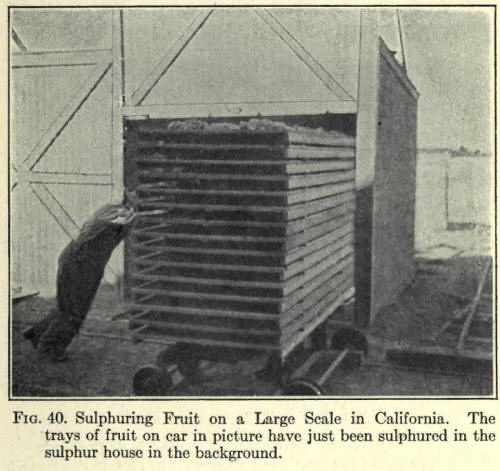
For drying small amounts
of fruit, improvised trays may be used. Cloth or paper will answer the
purpose or the fruit may he placed directly on a flat roof.
67. Sun Drying. A
dry hot climate, free from rains, is necessary for sun drying. Sun
drying requires less equipment and labor than drying by artificial heat.
There is more tendency for darkening of the fruit, for accumulation of
dust, and injury by insects or mold than is the case in artificial
drying. However, dried fruits of excellent quality are made by this
method.
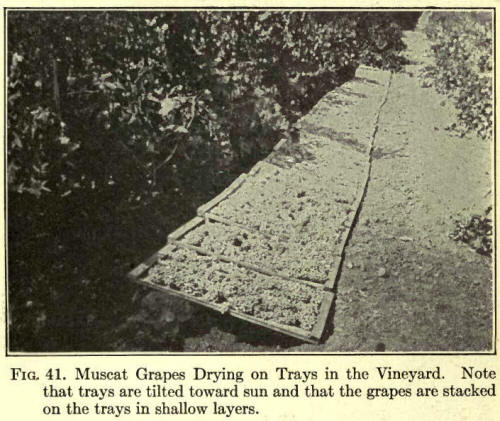
The fruit after
preparation by cutting, dipping, peeling, spreading on trays, and
sulphuring, as the case may require, is then exposed to the sun on trays
that are placed on the ground. The drying yard should be clean and as
free from dust as possible.
Grapes are turned when
about one-half dry by inverting a full tray over an empty one. Prunes
are stirred or turned several times during drying to cause even drying.
Other fruits are ordinarily not turned.
In case of a shower, the
trays are stacked in piles of a dozen or more trays each and covered
with empty trays or with boards to shed the rain. Late in the season
this often becomes necessary. During long rain storms or continued
cloudy weather, it is sometimes necessary to use artificial heat, or the
partially dried fruit must be
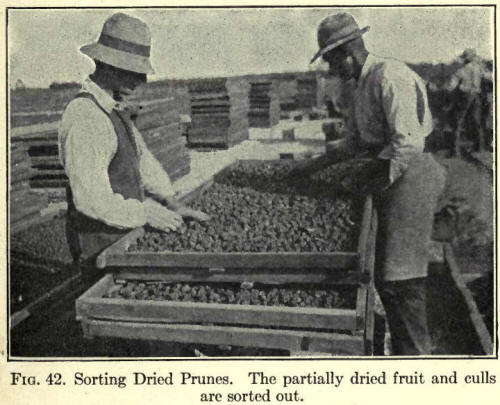
heavily sulphured to
prevent molding until there is again sufficient sunshine to permit
drying.
The fruit should not be
allowed to become too dry. The texture of the finished product should be
leathery, not hard and brittle. Excessive drying results in great loss
of flavor and makes the fruit difficult to cook.
The fruit will dry more
uniformly, the color will be better, and there will be less danger of
its becoming too dry, if the trays are stacked when the fruit is about
two-thirds dry. They should be stacked so that the air will pass freely
between them and complete the drying.
All of the fruit will not
dry at the same rate, and when most of it is sufficiently dry, it is
taken from the trays. That which is not dried sufficiently is left on
the trays a few days longer.
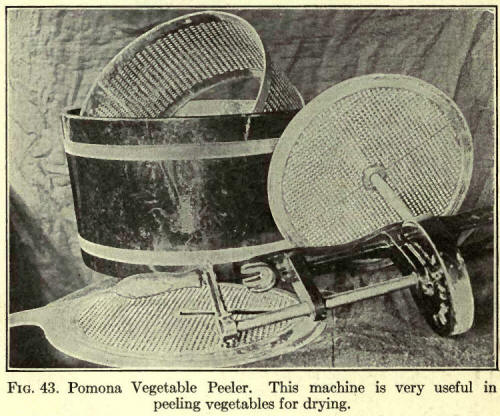
In good drying weather
most fruits are left four to six days in the sun, and about the same
length of time in the stack, making a total time of eight to twelve
days.
68. Artificial
Evaporation. The rate of removal of water by evaporation by sun or
artificial heat depends upon three factors: (1) temperature, (2)
humidity of the air, and (3) the rate at which the air passes over the
fruit. In many fruit growing sections, factors "1" and "2," or both, are
not favorable for sun drying, and artificial heat must be used.
Evaporators are of many
sizes and designs. An efficient dryer should take into account all three
of the above principles. The temperature in the evaporator may be raised
to about 115° F. for most fresh fruits and
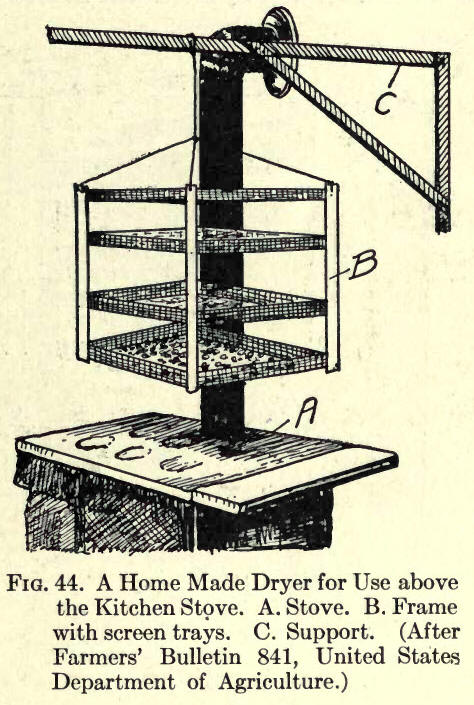
140° F. for fruit that
is.almost dry. Temperatures much above this cause scorching and severe
darkening of color. Thermometers should be used to record the
temperature in the dryer.
The humidity or moisture
content of the air passing through the dryer is exceedingly important.
If air is saturated with water vapor it will not cause drying,
regardless of the amount used; therefore, the evaporator cannot be made
so long that the air passing through becomes oversaturated with
moisture. A rise in temperature greatly increases the power of the air
to absorb moisture. Thus air at ordinary temperatures may be saturated
with water vapor, but when heated to 140° to
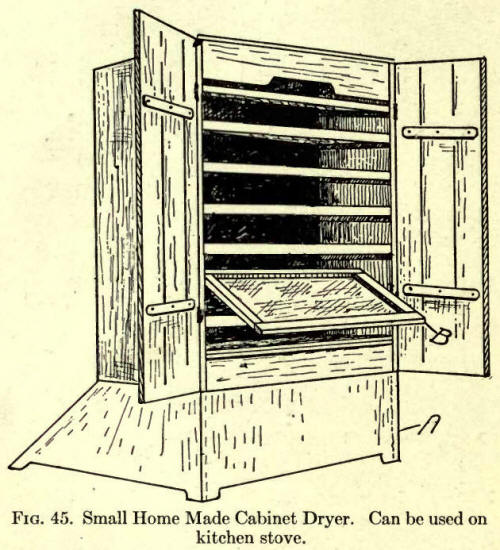
175° F., will again be
able to take up a very large amount of moisture. It must not, however,
be allowed to cool before it leaves the dryer, or the cooling will cause
the excess moisture to condense on the fruit at the upper end of the
dryer. If, therefore, the air is well heated, it will be "dry" before it
goes into the dryer regardless of its previous moisture content when
cold.
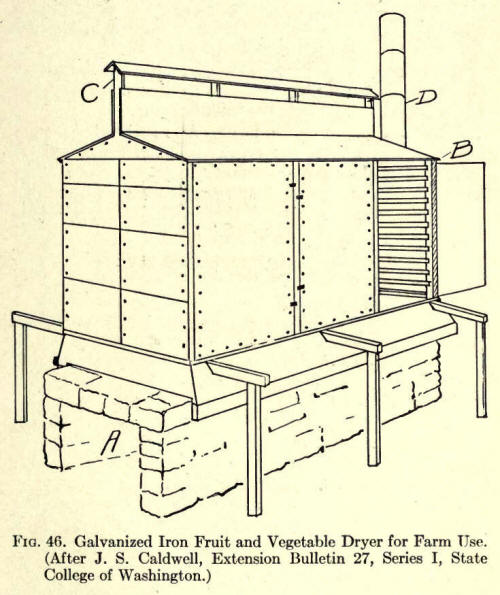
The importance of the
volume of the air passing over the fruit is a point often lost sight of
in building dryers. Air soon becomes saturated with moisture. If it is
not replaced with fresh air at once, the saturated air passes over the
remaining fruit without causing drying. If the air is supplied more
rapidly than it becomes saturated with water, drying proceeds throughout
the whole dryer. The rate of absorption of water vapor is greatest when
the warm air first enters the evaporator and before it has absorbed very
much moisture. Therefore, if the volume of air passed through is very
large, the rate of absorption is greatly increased, because the air is
constantly in the condition in which it most rapidly takes up water.
With these principles in
mind, the artificial dryer should be built so that an even temperature,
dry air, and a large supply of air are maintained.
A simple dryer for home
use can be constructed from a few pieces of galvanized coarse mesh
screen. This is hung or placed on metal supports above the stove. The
dryer consists of several of these screen trays placed one above the
other at about three-inch intervals. (See Fig. 44.)
A small cabinet dryer can
be made of rough lumber, an old stove, and a few lengths of stove pipe.
(See Fig. 45.)
For larger scale drying,
several types of evaporators are in use. The kiln dryer is one of the
cheapest.. A floor, usually 20 x 20 feet, made up of wooden strips with
spaces between for passage of hot air, forms the drying surface on which
the fruit is placed. Beneath the floor the flue or stove pipe from the
heater is placed. This is led back and forth across the dryer several
times to distribute the heat tinder the entire floor. A roof with a
large ventilator completes the dryer.
The tunnel dryer consists
usually of a wooden chamber 12 to 18 feet long and 6 x 3 feet in cross
section. It is sloping. Hot air flues pass beneath it. The trays slide
in on runways at the upper end and are taken out at the lower end. The
entering tray displaces one at the lower end. This dryer is used a great
deal for berries and prunes in the Pacific Northwest.
The cabinet evaporator
consists of an upright heating chamber into which the trays fit one
above the other. Heat is supplied at the bottom from hot flues or from
steam pipes. The fresh fruit is placed at the top. As a new tray goes
in, a tray of dried fruit is taken from the bottom of the stack, the
whole stack of trays automatically dropping the height of one tray. This
form of dryer is used in some apple drying sections.
The air blast evaporator
is one of the most satisfactory types. It is used for grapes and prunes
during rainy weather in the central portion of California. It consists
of a long narrow room the width of an eight-foot tray. At one end is a
large air fan. Back of the fan is a series of very hot flues. The trays
are stacked on trucks and run into the long chamber through side doors.
The fan draws the hot air over the flues and forces it through the
drying chamber over the fruit. The rate of drying is rapid and the
maximum efficiency of the heat is obtained because of the large volume
of air used.
Specific directions for
temperatures of drying, etc., for various fruits will be found in
recipes in Part III.
69. Sweating.
Fruit dries unevenly, some pieces being hard and dry and others not
quite dry enough when the bulk of the fruit has reached the desired
stage of dryness. The moisture content of the outer layers of the fruit
is less than that of the center of each piece. The moisture content is
equalized by storing the fruit in bins or large boxes for a time to
undergo " sweating," which is nothing more nor less than equalization of
the moisture. The sweat boxes or bin must be protected from insects and
should be kept dry and cool. The fruit is left in the sweat boxes about
two weeks, or until packed for final storage or market.
70. Processing and
Packing. Fruit dried in the sun usually becomes infested with
insects or insect eggs which would later produce larvae with resulting
loss of the fruit. Often the fruit may become too dry or may he dusty.
Treatment of the fruit
with boiling hot water for a short time will overcome the above defects.
This may be accomplished by placing the fruit in a wire basket and
immersing it in boiling water for about one minute. If it has been very
dry it may be packed at once; if only medium dry it may be necessary to
allow it to dry on trays a short time before packing.
Apricots, peaches, and
pears are sometimes sulphured for one to three hours after dipping in
hot water. This is often done to permit the fruit to absorb large
amounts of water without fermenting or molding—the sulphurous acid
acting as an antiseptic. Its use is not to be encouraged in treating
dried fruits for this purpose.
The packing of dried
fruits is an extensive industry, requiring rather elaborate and
expensive machinery and a variety of processes, which cannot be
described or discussed adequately in this volume.
Raisins are dried to an
almost anhydrous state at the packing house; are then stemmed in a
special machine; processed in hot water; and the raisins with seeds are
seeded in a complicated seeding machine.
Prunes are graded for
size according to number per pound. The seller is paid on a basis of
eighty prunes to the pound. He is penalized for all prunes requiring
more than eighty to the pound and is paid a premium for those requiring
less than eighty to the pound. After grading they are processed in hot
water and packed.
Dried fruit for market is
usually packed in paraffin paper lined wooden boxes of 20 to 50 pounds'
capacity, or in paper cartons of half pound to one pound size. Packed
fruit brings much better prices than bulk dried fruit. Attractive
packages are essential for successful marketing.
Dried fruit for home use
should be stored in insect-proof containers, away from rodents. Paper
bags, tight boxes, jars, etc., can be used. Ordinary cloth or burlap
bags are not suitable, because it is possible for insects to deposit
eggs through these.
A dry place should be
selected so that the fruit will not become moldy. |

